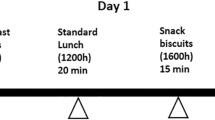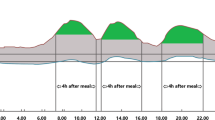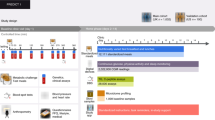Abstract
Background: Glycaemic glucose equivalent (GGE) content of a quantity of a food, based on glycaemic index, food composition and food quantity, is the theoretical weight of glucose that would induce a glycaemic response equivalent to that induced by the given amount of food.
Objectives: To test whether GGE content predicts glycaemic response to foods differing in glycaemic index, carbohydrate content and intake, over a practical range of carbohydrate intakes.
Design: Controlled randomised study.
Setting: Clinical trials unit at the Department of Human Nutrition, University of Otago, Dunedin, New Zealand.
Subjects: In all, 12 volunteers with and 12 without type II diabetes were recruited. All but one subject completed the trial.
Method: Yams, biscuits, white rice and porridge were consumed at 10 and 20 GGE doses, and 2-minute noodles at 24 and 48 GGE, following an overnight fast. Incremental areas under the blood glucose response curves (IAUC) over 3 h were calculated for each individual for all foods, and individual glycaemic responsiveness was determined as IAUC/GGE.
Results: Within GGE dose, blood glucose responses to all foods, except rice, were similar. Doubling GGE dose approximately doubled glycaemic response. Relative glycaemic effects were accurately predicted by GGE intake after adjusting for individual glycaemic sensitivity (individual average IAUC/GGE). The accuracy of prediction of relative glycaemic effect from GGE intake was affected little by carbohydrate dose.
Conclusion: GGE content predicted glycaemic impact of foods over a practical range of carbohydrate intakes, and may therefore be useful for accurate dietary management of glycaemia in diabetes mellitus. The predictive validity of GGE in mixed meals now needs to be tested.
Sponsorship: Health Research Council of New Zealand contract 00/453.
This is a preview of subscription content, access via your institution
Access options
Subscribe to this journal
Receive 12 print issues and online access
$259.00 per year
only $21.58 per issue
Buy this article
- Purchase on Springer Link
- Instant access to full article PDF
Prices may be subject to local taxes which are calculated during checkout



Similar content being viewed by others
References
Brand-Miller JC, Foster-Powell K & Colagiuri S (1996): The G.I. Factor. Australia: Hodder & Stoughton, Rydalmere, NSW.
Buchorn D (1997): Adjusted carbohydrate exchange: food exchanges for diabetes mellitus corrected with the glycaemic index. Aust. J. Nutr. Diet. 42, 65–68.
Colagiuri M, Brand-Miller JC, Swan V, Colagiuri M & Petocz P (1997): Glycaemic equivalents: exchanges based on both the glycaemic index and carbohydrate content of a food. Proc. Nutr. Soc. Aust. 21, 137.
Colagiuri S, Brand-Miller JC, Colagiuri M & Petocz P (1998): Glycaemic equivalents, studies in subjects with Type 2 diabetes. Proc. Nutr. Soc. Aust. 22, 108.
FOODfiles2000 (2000): Datafiles of the New Zealand Food Composition Database, version 11.0. OCNZ2000. Palmerston North, New Zealand: New Zealand Institute of Crop & Food Research.
Heaton KW, Marcus SN, Emmett PM & Bolton CH (1988): Particle size of wheat, maize, and oat test meals: effects on plasma glucose and insulin responses and on the rate of starch digestion in vitro. Am. J. Clin. Nutr. 47, 675–682.
Holt AHA & Brand-Miller J (1994): Particle size, satiety and the glycaemic response. Eur. J. Clin. Nutr. 48, 496–502.
Jenkins DJA, Wolever TMS, Taylor RH, Barker H, Fielden H, Baldwin JM, Bowling AC, Newman HC, Jenkins AL & Goff DV (1981): Glycaemic index of foods: a physiological basis for carbohydrate exchange. Am. J. Clin. Nutr. 34, 362–366.
Lee BM & Wolever TMS (1998): Effect of glucose, sucrose and fructose on plasma glucose and insulin responses in normal humans: comparison with white bread. Eur. J. Clin. Nutr. 52, 924–928.
Monro JA (1997): Glycaemic index and available carbohydrates in exchanges of New Zealand Foods. Proc. Nutr. Soc. NZ 22, 241–248.
Monro JA (1999a): Available carbohydrate data and glycemic index combined in new data sets for managing glycaemia and diabetes. J. Food Comp. Anal. 12, 71–82.
Monro JA (1999b): Food exchange tables for control of postprandial glycaemia. J. NZ Diet. Assoc. 53, 11–21.
Monro JA & Williams M (2000): Concurrent management of postprandial glycaemia and nutrient intake using glycaemic glucose equivalents, food composition data, and computer-assisted meal design. Asia Pac. J. Clin. Nutr. 9, 67–73.
Monro JA (2001): Glycaemic index-based classifications do not reflect the relative glycaemic impact of foods. Proc Nutr. Soc NZ 24 (In press).
Monro JA (2002): Glycaemic glucose equivalents: combining carbohydrate content, quantity and glycaemic index of foods for precision in glycaemia management. Asia Pac. J. Clin. Nutr. 11, 217–225.
Perry T, Mann J, Mehalski KA, Gayya C, Wilson J & Thompson C (2000): Glycaemic index of New Zealand foods. NZ Med.J 113, 140–142.
Read NW, Welch IM, Austen CJ, Barnish C, Bartlett CE, Baxter AJ, Brown G, Compton ME, Hume KE, Storie I & Worlding J (1986): Swallowing food without chewing; a simple way to reduce postprandial glycaemia. Br. J. Nutr. 55, 43–47.
Salmeron J, Manson JE, Stampfer MJ, Colditz GA, Wing AL & Willet WC (1997): Dietary fibre, glycaemic load, and risk of non-insulin-dependent diabetes mellitus in women. JAMA 277, 472–477.
Voyatzoglou D, Loupa C, Philippides P, Siskoudis P, Kitsou E, Alevizou V, Manglara E & Katsilambros N (1995): Insulin response to legumes in Type 2 diabetic persons. Eur. J. Int. Med. 6, 201–203.
Wolever TMS, Jenkins DJA, Jenkins AL & Josse RJ (1991): The glycaemic index: methodology and clinical implications. Am. J. Clin. Nutr. 54, 846–854.
Wolever TMS, Katzman-Relle L, Jenkins AL, Vuksan V, Josse RG & Jenkins DJA (1994): Glycaemic index of 102 complex carbohydrate foods in patients with diabetes. Nutr. Res. 14, 651–669.
Wolever TMS & Bolognesi C (1996a): Source and amount of carbohydrate affect postprandial glucose and insulin in normal subjects. J. Nutr. 126, 2798–2806.
Wolever TMS & Bolognesi C (1996b): Prediction of glucose and insulin responses of normal subjects after consuming mixed meals varying in energy, protein, fat, carbohydrate and glycemic index. J. Nutr. 126, 2807–2812.
Acknowledgements
The authors thank Margaret Waldron and Karen Taylor for specialist nursing and research assistance during this study, and Ashley Duncan and Michelle Harper for laboratory assistance.
Author information
Authors and Affiliations
Contributions
Guarantor: J A Monro.
Contributors: JAM conceived the study. JAM, TP and PL designed the study. PL recruited subjects and collected and entered the data. PL was responsible for feeding, sampling and analyses for her MSc thesis, with supervision by TP (mainly) and JAM. PL and TP communicated with the statistics unit, University of Otago. JAM conducted further data analyses. JAM, PL and TP interpreted the results. JAM and PL wrote the paper.
Corresponding author
Rights and permissions
About this article
Cite this article
Liu, P., Perry, T. & Monro, J. Glycaemic glucose equivalent: validation as a predictor of the relative glycaemic effect of foods. Eur J Clin Nutr 57, 1141–1149 (2003). https://doi.org/10.1038/sj.ejcn.1601656
Received:
Revised:
Accepted:
Published:
Issue Date:
DOI: https://doi.org/10.1038/sj.ejcn.1601656
Keywords
This article is cited by
-
Glycaemic glucose equivalents: response to Wolever
European Journal of Clinical Nutrition (2005)
-
Comment on validity of glycaemic glucose equivalent
European Journal of Clinical Nutrition (2004)
-
Virtual food components: functional food effects expressed as food components
European Journal of Clinical Nutrition (2004)



